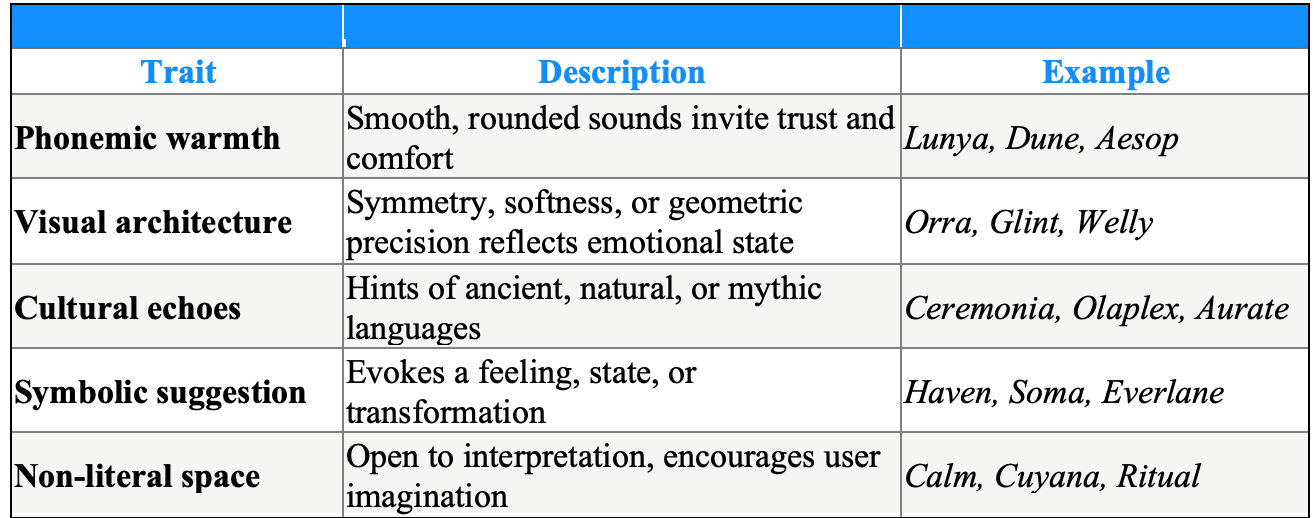The Rise of Semiotic Branding: Naming for Feel, Not Function
Introduction: From Definition to Vibration
In the beginning, brand names served a straightforward purpose: to identify and describe. They signaled utility, category, or origin—Pampers pampers, Snapple snaps and apples, Coca-Cola combines cocoa and kola nuts. But today’s consumers don’t buy the function—they buy the feeling. They buy resonance, aesthetic presence, identity projection, and narrative implication. We are entering a new era: the age of semiotic branding, where names are chosen not for their direct meaning, but for their emotional, cultural, and symbolic valence.
This shift—accelerated by visual culture, AI compression of attention, and linguistic fatigue—demands a radical reevaluation of naming. Function is no longer the starting point. Feel is.
What Is Semiotic Branding?
Semiotic branding refers to naming strategies that prioritize symbolic association, emotional tone, and cultural encoding over literal description or functionality. In this context, the name becomes:
• A vibe
• A code
• A container for evolving meaning
• A social and aesthetic signal
Rather than ask What does this name mean?, semiotic branding asks:
How does this name behave in the mind?
Examples:
• Glossier – not “makeup,” but soft, glowing proximity
• Oatly – not “oat milk,” but quirky anti-authoritarian humor
• Hims / Hers – not “telemedicine,” but sleek, everyday intimacy
• BeReal – not “photo app,” but realness as ritual
These names function like visual poems—quick to ingest, emotionally sticky, and open to interpretation.
What Killed Literalism?
Several cultural and commercial factors have accelerated the decline of literal naming in favor of semiotic naming:
1. Brand Saturation
With over 3,000 new trademarks filed daily in the U.S. alone, all the good literal names are taken—or worse, sound generic.
2. Platform Compression
On TikTok, Instagram, and X, you don’t get a paragraph to explain your brand. You get a glimpse. A gesture. The name has to do emotional heavy lifting instantly.
3. Consumer Burnout
Literal names often sound clinical, corporate, or over-optimized. They lack mystery, play, or self-expression. Today’s consumer wants brands that speak around the product, not at them.
4. The Rise of AI Prompt Culture
As more content is generated, people crave human-coded signals: visual weirdness, phonetic texture, emotional specificity. Names must feel authored—not assembled.
The Anatomy of a Semiotic Brand Name
What makes a name “semiotic”? It’s not just abstraction. It’s meaning in potential, emotional bandwidth, and symbolic ambiguity. Strong semiotic brand names typically share the following traits:
Semiotic names become atmospheres, not explanations.
AccuBrand™ and Testing for Feel
At Brand Acumen, our AccuBrand™ validation methodology measures more than recall or phonetic ease—we test emotive response, cultural fluency, and semantic drift tolerance.
How we test “feel”:
• Mood congruence testing: Does the name match the emotional tone of the brand experience?
• Implicit response testing: Does the name trigger subconscious alignment or friction?
• Cross-cultural semiotic mapping: How does the name “resonate” across languages and visual systems?
• Symbolic residue analysis: What visual, sonic, or historical baggage does the name carry without saying it?
For instance, when evaluating names for a new neuro-wellness brand, one candidate (Veura) outperformed all functionally descriptive options (MindLift, NeuroSync) in both trust and affinity—despite having no explicit reference to the brain.
Strategic Implications for Brand Builders
1. Function is easy. Feel is rare.
Your product benefits may be shared by 20 competitors. Your aesthetic tone is what sets you apart.
2. Don’t explain. Invite.
Let the name act as a portal, not a summary.
3. Use abstraction responsibly.
Semiotic names are not excuses for vagueness. They require clear emotional architecture and tight visual storytelling.
4. Build symbolic systems.
Pair your name with intentional iconography, language rhythm, and packaging tone to create a full semiotic universe.
5. Test like a poet, not a lawyer.
Legal clearance is necessary. But resonance is everything. Use tools like AccuBrand™ to measure not what the name is, but what it feels like over time.
The Future of Semiotic Naming
We predict that by 2027, 70% of new CPG, fashion, wellness, and tech brands will use non-literal, emotionally toned, semiotic-first names. Why?
Because brands are becoming:
• Aesthetic rituals
• Digital personalities
• Cultural codes
In a world where AI can write your slogan and your brand voice, the name becomes your last handmade object—a vessel for depth, mystery, and emotional truth.
Naming That Touches, Not Tells
Semiotic branding is not about abandoning meaning—it’s about refining it. It’s the art of naming for emotion, sensation, and implication rather than description.
The best brand names today don’t declare what they are.
They invite us to feel something, and in that feeling, we understand everything.
Want your next name to resonate beyond category?
Let Brand Acumen help you build a name that feels right before it ever means right.
Explore our AccuBrand™ methodology and future-proof your brand's emotional imprint.
CONTACT US: marketing@brandacumenstudios.com





